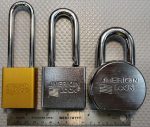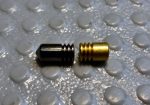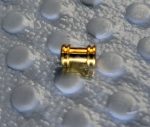
So, are you sure you’re ready for this? Of course you are! Everyone makes a big deal about serrated pins but they’re just like any other pin once you get the hang of them. Like spools, they’ll give you a distinct “signal” of their presence and have a unique “feel”. Admittedly, that feel is more subtle than with spools, but that’s why we’re progressing through this logically and taking time for you to refine both your manual dexterity and “feel”.

The first thing you’ll want to know is where to get a lock with serrated pins, and nothing could be easier. All American brand padlocks contain serrated pins. Some of the recently manufactured American brand locks contain serrated spools as well, which have a unique feel. Surprisingly, the 1200-series aluminum body locks sell for under $10 on eBay and contain an identical core as their bigger, more expensive brothers. This is the most challenging pin-type that you’ll face and requires some dedication and practice to develop your feel.
American also started putting in a hybrid pin, the serrated spool. While these LOOK intimidating, they are nothing special.
The secret: Extraordinarily light tension that allows you to feel the “clicks” as each serration passes the shear line. Serrated pins bind just like all the other pins that you’ve already mastered, but here’s the difference: when you pick a serrated pin, give it a single “click”. That click tells you that the pin has either reached the shear line, OR you’ve picked the pin into one of the serrations. Now this is where everyone screws up. Once you’ve gotten the first click, STOP picking that pin! Check the others in the lock to see if there’s another binding pin. If there IS, then the first pin IS picked, great! If none of the remaining pins are binding, that tells you that the first pin is hung up on one of the serrations and you need to pick it again, to the SECOND click. Repeat this until you find another binding pin, because when you DO, that is the signal that the first serrated pin is at the shear line. Keep repeating this until you’ve picked all the serrated pins.
The second secret is patience. If you rush picking serrated pins you will fail. Nobody is lucky enough to find the shear line on the first try on all of the pins. Serrated pins take time to pick, but other than that they are nothing special. I call it “counting clicks”.

American Lock Company (now owned by Master Lock, unfortunately) also uses serrated key pins to further slow you down. To us, this is irrelevant. We are counting clicks and looking for a binding pin. Where the serrations occur on the pins doesn’t matter in the least to us. Just keep counting clicks and looking for the binding pin to change, and you’ll master these in no time.
American also started putting in a hybrid pin, the serrated spool. While these LOOK intimidating, they are nothing special. In fact, if your lock goes into a false set after the second click, you’ll know EXACTLY what you have. Handle it exactly the same way you handle normal spools. Once you hit the false set, there are no more serrations on that pin to deal with. I actually LIKE hitting these because spool picking is a lot easier and faster than serrated pin picking.
This video may help you:
By now you’re a proficient lock picker and ready to broaden your skills even further by specializing in specific types of locks. We all go through this phase but often choose different paths. Some guys are obsessed with Abloys, and spend the rest of their lives studying them, trying to figure out how to beat them. Others opt for pin-in-pin style locks, like Mul-t-lock. Still others get hooked on Medecos. These are the big 3, but there are LOTS of locks out there for you to learn about.
Your pin tumbler skills are about as advanced as we can get them, it’s time to see what else is out there. Jump right to LP402!